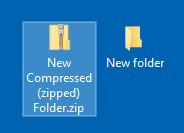It is no secret that most files and folders require more disk space than necessary. Over the years there have been many different methods proposed to "compress" those files and folders so that you can get more information into a smaller space. One of the oldest and most persistent compressed file formats is known as a "ZIP file." Introduced in 1989 by Phil Katz, the algorithms used in the format have been released to the public domain and it has become the de facto standard for simple file compression.
Why would you want to store information in a compressed file? Easy—it takes less space. Thus, if you need to send a lot of information to another person (say, over the Internet), it is faster to send a compressed file than it is to send the files in their native format.
Windows has directly supported ZIP file formats—to one degree or another—since Windows 98. (Technically Windows 98 only supported ZIP files if the Plus! pack was added. Versions of Windows since then have had the capability built in.) This means that you can place a ZIP file on your desktop and Windows treats it just like a file folder.
You can see how this works by creating a ZIP file on your desktop. Perform these steps:
You can tell a compressed folder from a regular folder by looking at its icon. The compressed folder has a zipper that appears on the folder. (See Figure 1.)

Figure 1. Zipped (compressed) folders show a zipper on the folder icon.
From this point on you can treat the compressed folder the same as you would any other folder on your system. You can move files and other folders into it or out of it. The trick is to remember that the compressed folder is really a file—a ZIP file. You can easily transfer the file to someone else by copying it to a thumb drive or by sending it via e-mail as an attachment.
![]()
![]()
![]() This tip (5853) applies to Windows 7, 8, and 10.
This tip (5853) applies to Windows 7, 8, and 10.
If you need access to files on a network but aren't always on the network, you may find that the offline files feature of ...
Discover MoreIf your system gets into a state where it cannot be started normally, this tip presents you with options of how you can ...
Discover MoreBeing able to restore from a backup is just as important as making the backup in the first place. This tip tells you how ...
Discover More2019-08-26 13:00:59
Allan
I would like to learn this technique. When I Click the Compressed (Zipped) Folder option it creates a VLC zipped folder. When I do a Send to...>VLC it will not open.
Help please.
2019-08-26 06:08:15
Gary Evans
Since an update to Windows 10 a few weeks ago I have noticed that ZIP files are much larger than they used to be. Has anyone else noticed this?
Copyright © 2026 Sharon Parq Associates, Inc.
Comments